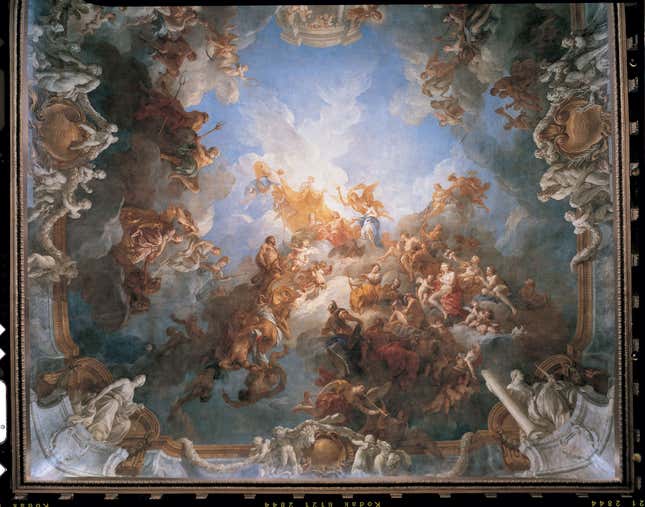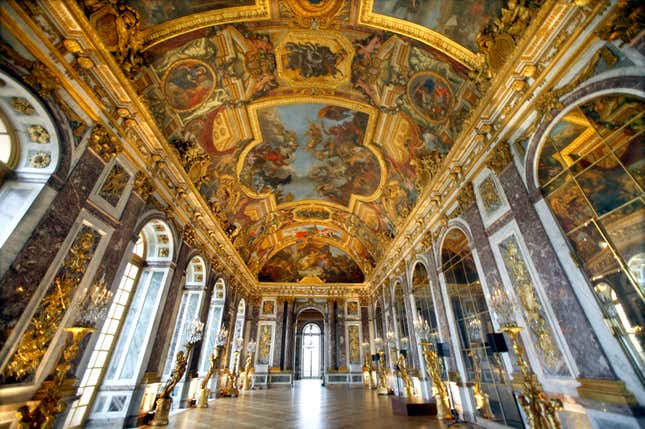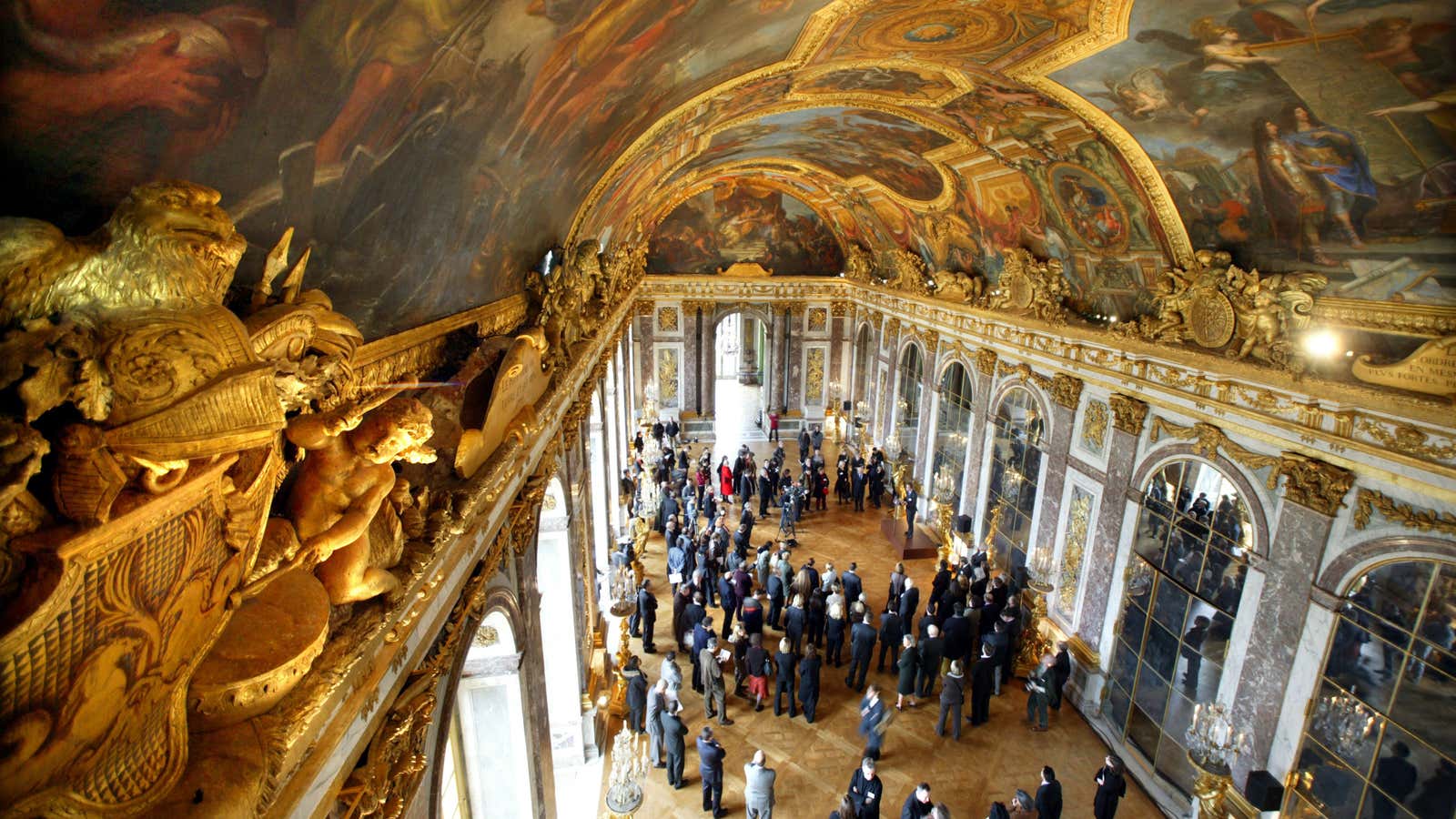A new kind of winged creature is making its way to US politics: The golden cherub looks poised to usurp the place of the traditional bald eagle.
Compared to the staid eagle, a symbol of political power in many national emblems, the cherub evokes wealth and whimsy. Originating in ancient Greco-Roman art, the baby angel found in many religious paintings was elevated to a symbol of opulence by the court of French king Louis XIV at Versailles. Today, it is a kind of shorthand for in-your-face affluence—and a motif favored by US president-elect Donald Trump.
Cherubs decorate commodes, candelabras, and ceilings in Trump’s lavish penthouse apartment where he currently holds court. Last month, he hosted Japanese prime minister Shinzo Abe at Trump Tower for a closed affair witnessed only by Abe’s public relations team, Trump’s children, and the choir of frolicking cherubs hovering above them on the murals on the ceiling.
Surrounding oneself with cherubs and kingly gold is unusual in US political theatre. It’s in startling contrast to the beige, neoclassical interiors and worn-out federal style furniture of most US government offices. But it’s one of the oldest tricks in the book, as far as politically symbolic décor. Cherubs (also known as putti) have long framed kings and rulers in Western art history, art historian Mimi Hellman explains. “Their presence contributed to a message about triumph and glory—a king’s conquests in war, the authority of certain values, the greatness of heroes, or the victory of love over strife,” she says.

Cherubs also historically signify wealth, Hellman adds. In private homes in 15th, 16th and 17th century Europe, finely carved cherubs suggested abundance and carefree frivolity. “They were fanciful, amusing creatures—chubby, frolicking, winged babies in an era when real live children rarely looked so healthy and were not allowed to tumble around with abandon,” she says. “The virtuoso workmanship that went into painting, sculpting, and often gilding them helped to demonstrate the owner’s wealth and patronage power.”
The most reproduced cherubs in Western art are the two cupids on the bottom of the altar piece painting Sistine Madonna by Raphael. But Trump’s cherub crush likely has less to do less with religion than with status: Today, the cherub motif is frequently used in packaging, logos, and greeting cards to convey a sentimentality for Old World prestige. As Hellman explains, “they defy the spare aesthetics of modernism and link a consumer’s taste and social identity to those of kings and aristocrats.”
Melania Trump, who claims to have studied design and architecture in the University of Ljubljana, may have had an influence on Trump’s preference for ornamental chubby angels. Designer Kelly van Patter, who recreated Trump’s Manhattan penthouse for his reality TV show The Apprentice, recalls the future first lady fawning over the set’s French baroque touches.”We love the gold antiques and cherubs and want to order more from wherever you got them,” said Melania to van Patter.
“I call it Trump-a-coco,” van Patter tells the Hollywood Reporter, riffing on the florid 18th-century rococo style.
Donald Trump, designer-in-chief
Trump is famously authoritarian when it comes to design, so it’s unlikely that any decorative elements surrounding him are there without his express approval. From the font on his teleprompter at the Republican National Convention, to the specific brass material in his hotel bars, to his controversial family coat of arms, Trump gets the final word on design decisions for anything with his name on it.
Though daughter Ivanka is listed as the interior decorating czar for the Trump organization, van Patter remembers the real estate mogul as “never too busy for decorating decisions.”
Known to dismiss professional advice from his interior designers at times, Trump insists on big design overtures. His decorating style, which he weirdly describes as “comfortable modernism,” is consistent with his company’s bold-and-gold visual branding: “He is synonymous with brazen success and wealth,” as Forbes observed.
Powerful men around the world have tended to demonstrate an affinity for the same French baroque look, as many point out. “The gilding applied to walls and furniture wherever possible, columns in veined colored marble, painted ceilings with mythological scenes, and walls covered in mirrors…the closest thing to the Trump penthouse is Robert Mugabe’s palace in Zimbabwe,” says interior designer David Desmond , noting the similarity to the 25-bedroom mansion of the 92-year old despotic leader.
The Palace of Versailles is key to understanding this aesthetic. The 17-century court at Versailles, a classic case study of soft power, is frequently referenced by rulers hoping to symbolically shore up their stature. ”Think French,” suggests author Peter York in a playful style guide for dictators in his 2006 book, Dictator Style: Lifestyles of the World’s Most Colorful Despots: “French decoration and furniture has been the taste of New Money for 150 years. Cast your mind back to curvy marble chimney pieces, oval-backed gilt chairs and massive commodes covered in golden ormolu…”
Throughout his 72-year reign, France’s famously vain Louis XIV used such furniture, painting, tapestry, sculpture, silver and mosaics—many decorated with choirs of cherubs—to transform his father’s modest hunting lodge to the most beautiful royal palace in the world. This total design makeover of Versailles bolstered the “Sun King’s” stature and sealed his position as an influential world leader.
Trump’s decorator, the late Angelo Donghia, deliberately fashioned his penthouse after Louis XIV’s French baroque style; Versailles’s Hall of Mirrors was an inspiration for its mirrored walls.

But as Desmond points out, the opulent royal style is an odd choice for an elected head of state. “Louis XIV’s decoration of Versailles is an expression of the king’s [divine] right to rule—the opposite of the president’s role in American democracy,” he says. Although innocent in appearance, cherubs have often heralded a leadership style founded on personal stature and vanity.




